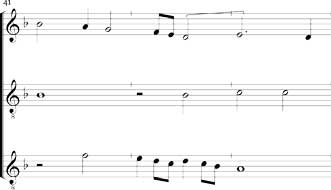S’il vous plaist bien que je vous tiengne 3v · Anonymous
Appearance in the group of related chansonniers:
*Dijon ff. 119v-121 »S’il vous plaist que je vous tiegne« 3v · Edition · Facsimile
*Nivelle ff. 13v-15 »S’il vous plaist bien que je vous tiengne« 3v · Edition · Facsimile
This page with editions as a PDF
Edition: Perkins 1999 pp. 338-339 (Nivelle).
Text: Bergerette; full text in both sources; also found in Paris 1719 f. 90, Paris 1722 f. 42v.
After Nivelle:
|
S’il vous plaist bien que je vous tiengne 1) Car que je sceusse vivre ainsi 2) ma dame, sans voustre mercy, Ja besoing n’est que j’entreprengne 3) S’il vous plaist bien que je vous tiengne |
If it pleases you that I regard you Though I could live in this way my lady, without your mercy, There is no need that I go on, If it pleases you that I regard you |
1) Dijon, line 2, “S’il vous plaist que je ...” (error)
2) Dijon, line 5, “Car que je sceusses vivre ...”
3) Dijon, line 9, “Ja n’est besoing n’est que j’emtepreigne” (error)
Evaluation of the sources:
The main scribes of the two chansonniers have copied this anonymous bergerette with the use of the same exemplar or very similar exemplars. There are very few differences in ligatures and coloration and a couple of instances where Dijon has more decorative notes than Nivelle (S bb. 24 and 50), otherwise the most significant difference occurs in the contratenor in the second ending to the couplets. Here, an awkward passage appears in Dijon bars 63-64, especially the note e against g-bb' is unfortunate. Nivelle has a better reading of this passage, maybe an editorial intervention. The sound of parallel fifths in Dijon in bar 63 may be caused by a simple writing error, a displacement of the punctus belonging to the ligature, but the dissonances in the next bar may well have been in the Dijon scribe’s exemplar. This seems credible since both sources agree on an equally unfortunate passage in bars 41-42, where parallel seconds occur between the superius and the countertenor. These bars would be quite easy to improve with something similar to ex. 1.
Ex. 1. A hypothetical revision of bars 41-43

The two sections of the bergerette are both in double time, the first in tempus imperfectum and the second is diminished. It is the same rhythmic relationship that we meet in well-known bergerettes as »Ma bouche rit et ma pensee pleure« by Ockeghem or »Ja que lui ne s'i actende« by Busnoys. In performance, a strict doubling of the tempo was probably not intended, the meaning was rather that the beat changes from the semibrevis to the brevis, with the breves performed a bit slower than the semibreves in the preceding section. In this way the rhythmic relation between the refrain/tierce and the couplets becomes quite similar to the 4:3 relationships we find in most bergerettes in tempus perfectum with couplets in imperfectum diminutum. (1)
Comments on text and music:
This plea for a gracious answer from the woman adored, a bergerette in rich rimes, is set to music for three voices in quite common ranges, a wide-ranging upper voice placed between g and c'', a tenor e-a' and a contratenor in a slightly lower range, d-f', which occasionally crosses above the tenor. The setting is enlivened by canonic imitation at the octave between the upper voices in the third and fourth lines of the refrain and in the couplets’ second line. The imitation motifs are very simple and all are kept within the F-hexachord. The song’s best moment comes at its beginning, whose homorhythmic declamation does not reveal the song's double mensuration but in a smooth flow presents the full range of the voices in the cadence-less first line. Hereafter the refrain’s music becomes a bit square and plods along until the phrase leading to the final cadence. What disturbs the impression of the song is in particular the restricted ranges of the upper voices in bars 16 ff – boring because of sheer incompetence in contrapuntal writing –, that the composer seemingly found it difficult to design a contratenor below the tenor while avoiding parallels, and finally the dissonances caused by the short note values at several points.
In his article ‘Conflicting Attributions and Anonymous Chansons in the ‘Busnoys’ Sources of the Fifteenth Century’, Leeman L. Perkins discussed this song as a possible composition by Antoine Busnoys. (2) Here he enumerated all the features that can be favourably compared to the characteristics found in Busnoys' songs, while the anonymous composer's shaky competence is not taken into account. A comparison with the two bergerettes mentioned above by Busnoys and Ockeghem does not turn out in the song's favour.
PWCH January 2025
1) See further on diminution of tempus imperfectum in my introduction to Johannes Ockeghem, Missa Quinti toni. Edited with an introduction by Peter Woetmann Christoffersen, June 2021, pp. xxi-xxiii. (http://www.sacred.pwch.dk/Ma_Ock01.pdf).
2) In Paula Higgins (ed.), Antoine Busnoys. Method, Meaning, and Context in Late Medieval Music. Oxford (Clarendon Press) 1999, pp. 317-358, at pp. 334-340.